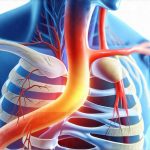Prolonged sitting is often framed as a modern occupational hazard, detrimental primarily to posture and muscle strength. However, its impact extends far beyond these physical aspects, particularly when combined with the physiological state following food consumption. The simple act of remaining seated for an extended period after eating can create a cascade of effects, subtly contributing to increased abdominal pressure, digestive discomfort, and even nausea in susceptible individuals. This is often overlooked because it isn’t typically associated with acute illness or injury but rather emerges as a chronic, low-grade stressor on the body’s systems. Understanding this connection is crucial for promoting mindful habits that support overall well-being.
The issue arises from a confluence of factors. Digestion itself requires energy and increases blood flow to the gastrointestinal tract. When combined with postural compression from sitting – which restricts diaphragmatic breathing, limits space for abdominal organs, and decreases lymphatic drainage – the digestive process becomes less efficient and more prone to creating discomfort. This isn’t about avoiding rest after a meal; it’s about recognizing that how we rest significantly impacts our body’s ability to effectively manage the postprandial (after-meal) state. The modern lifestyle, characterized by prolonged sedentary behavior even during and immediately following meals, exacerbates these effects, potentially leading to chronic issues or acute episodes of nausea and digestive distress. If you are prone to nausea after eating, learning how to structure meals can be very helpful.
Physiological Mechanisms Linking Sitting & Digestive Discomfort
The core problem lies in how prolonged sitting disrupts the natural physiological processes involved in digestion. When we sit, especially with poor posture, we compress the abdominal cavity. This compression directly impacts the organs within – stomach, intestines, liver, pancreas – reducing their optimal functioning space and potentially hindering peristalsis (the wave-like muscle contractions that move food through the digestive tract). Furthermore, a slumped or rigid sitting position restricts diaphragmatic breathing; instead of deep, expansive breaths utilizing the diaphragm, we tend to breathe shallowly from the chest. This creates increased intra-abdominal pressure and can impede proper gas exchange, which is vital for overall bodily function.
This combination of physical compression and altered breathing patterns doesn’t just affect digestion directly. It also impacts the vagus nerve, a critical component of the parasympathetic nervous system (often referred to as the “rest and digest” system). The vagus nerve plays a central role in regulating digestive processes, heart rate variability, and even mood. Chronic compression can interfere with vagal tone – essentially weakening its signaling capabilities – leading to impaired digestion, increased stress response, and potentially contributing to symptoms like nausea. Imagine trying to efficiently process food while simultaneously battling restricted breathing and a compromised nervous system; it’s a recipe for digestive distress.
The effect is amplified by the natural physiological changes that occur after eating. Blood flow increases to the gut to facilitate digestion, meaning there’s less blood available elsewhere in the body. Sitting exacerbates this shift, potentially leading to feelings of sluggishness or even lightheadedness. This localized increase in blood volume within the abdomen contributes further to pressure, and when combined with restricted movement, can create a vicious cycle of discomfort. Understanding how dehydration impacts these processes is also important.
Impact on Abdominal Pressure & Nausea
Abdominal pressure isn’t inherently bad; it’s a natural part of digestion. However, prolonged and excessive abdominal pressure becomes problematic. When the abdomen is consistently compressed through sitting, the internal organs are subjected to increased force. This can lead to several issues including: – Gastroesophageal reflux (heartburn) due to increased pressure on the lower esophageal sphincter; – Impaired lymphatic drainage, leading to bloating and discomfort; – Potential for hernias or other structural changes over time. Nausea, often a precursor to vomiting, is a complex physiological response triggered by multiple factors. While commonly associated with toxins or infections, it can also be induced by increased intracranial pressure (pressure within the skull) and, crucially, by signals from the digestive system itself.
The heightened abdominal pressure created by prolonged sitting after eating can directly stimulate these nausea pathways. The vagus nerve, already potentially compromised as described above, becomes even more sensitive to changes in gut motility and distension. When the stomach or intestines become overly full or experience disrupted movement due to compression, signals are sent to the brain triggering feelings of nausea. This is particularly pronounced in individuals with pre-existing digestive sensitivities like Irritable Bowel Syndrome (IBS) or functional dyspepsia.
The sensation isn’t necessarily a violent, immediate reaction; more often it’s a low-grade, lingering discomfort that many dismiss as simply feeling “full” or “bloated.” However, this constant subtle pressure can contribute to chronic digestive issues and negatively impact overall quality of life. It also highlights the importance of mindful movement and postural changes after meals. A healthy gut microbiome is vital; consider how exposure to nature can benefit it.
Addressing Postprandial Discomfort: Practical Strategies
The good news is that mitigating these effects is often achievable through simple lifestyle adjustments. The key is to break up prolonged sitting, especially immediately following a meal. Here are some practical strategies: – Take short walks: Even a five-to-ten minute walk after eating can significantly improve digestion and reduce abdominal pressure. This gentle movement encourages peristalsis and promotes lymphatic drainage. – Incorporate postural changes: If walking isn’t possible, stand up and stretch every 20-30 minutes. Simple stretches that open the chest and abdomen can help relieve compression. – Practice mindful eating: Slow down your eating pace, chew thoroughly, and focus on savoring your food. This aids digestion and reduces the likelihood of overeating (and subsequent bloating).
Beyond these immediate steps, consider optimizing your overall sitting posture. Invest in an ergonomic chair that supports proper spinal alignment and encourages a more open chest position. Avoid slouching and aim to maintain a neutral spine throughout the day. Remember that movement is medicine – incorporating regular physical activity into your routine will not only benefit digestion but also improve overall health and well-being. Optimizing breakfast can be a great start to the day, preventing sluggishness later on.
The Role of Breathing & Vagal Tone
As mentioned earlier, diaphragmatic breathing plays a crucial role in regulating digestive function and reducing abdominal pressure. Consciously practicing deep, belly breaths can activate the parasympathetic nervous system, promoting relaxation and improving vagal tone. – Diaphragmatic breathing exercise: Lie on your back with knees bent and feet flat on the floor. Place one hand on your chest and the other on your abdomen. Breathe in deeply through your nose, allowing your abdomen to rise while keeping your chest relatively still. Exhale slowly through your mouth, feeling your abdomen fall.
Regular practice of diaphragmatic breathing can help strengthen the vagus nerve, improving its signaling capabilities and enhancing digestive function. Additionally, techniques like yoga or meditation, which emphasize mindful breathing and relaxation, can be incredibly beneficial for reducing stress and promoting overall well-being. These practices are not just about physical health; they’re about cultivating a deeper connection between mind, body, and digestion. Understanding the link between poor gut health and overall well being is also important.
Identifying Underlying Sensitivities & Seeking Support
While these strategies can often alleviate mild postprandial discomfort, it’s important to recognize that some individuals may have underlying sensitivities or conditions that require further attention. If nausea or digestive distress persists despite lifestyle adjustments, consider consulting with a healthcare professional. – Food intolerances: Identify potential food triggers through elimination diets or allergy testing. – Gastrointestinal disorders: Rule out conditions like IBS, GERD, or functional dyspepsia. – Stress management: Address chronic stress levels, as they can significantly impact digestive function.
Remember that everyone’s body is different. What works for one person may not work for another. The key is to listen to your body, experiment with different strategies, and seek professional guidance when needed. Prioritizing mindful habits – incorporating movement, practicing deep breathing, and addressing underlying sensitivities – can empower you to take control of your digestive health and enjoy a more comfortable and fulfilling life. If intermittent fasting disrupts balance, learn how to recover gut balance. Finally, consider balancing gut acidity for improved absorption.


















